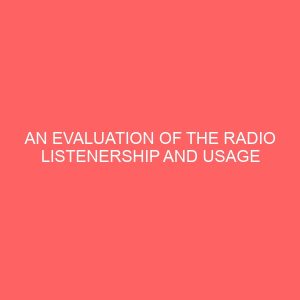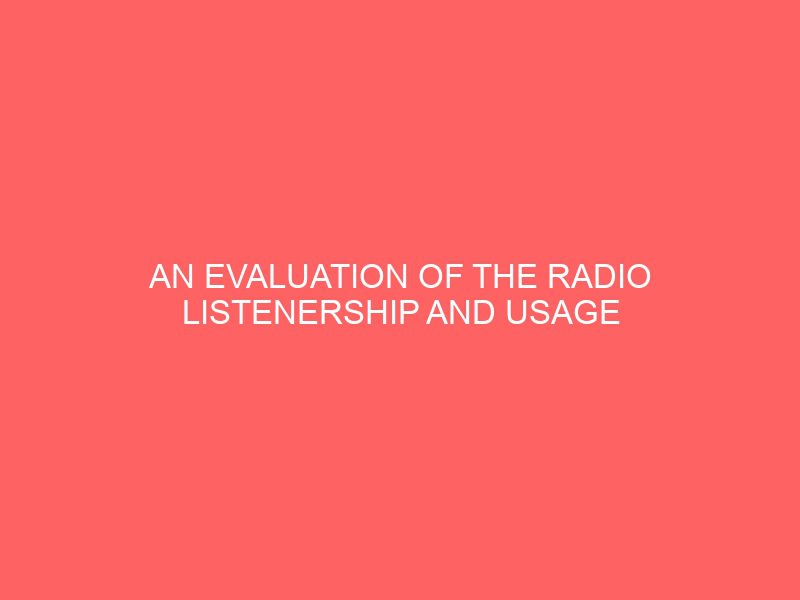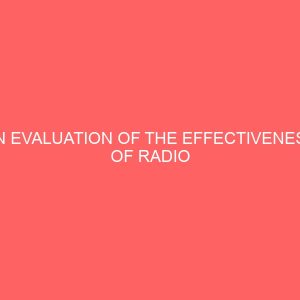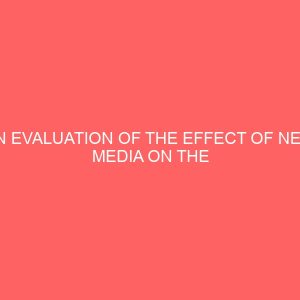Description
CHAPTER ONE
INTRODUCTION
1.1 BACKGROUND TO THE STUDY
Without equivocation, radio broadcasting in Nigeria began in 1932 with the introduction of wired broadcasting popularly known as Radio Distribution Service, (RDS). Under this form of broadcasting, programs were relayed or distributed using wires connected to loud speakers installed in the homes of subscribers who had paid a small subscription fee for this system and were also provided with a make shift and home apparatus (Uche,1989). The Lagos studio distributed programs originating from the British Empire Service from Daventry, England as part of the British Broadcasting Corporation (BBC) external service. The increasing popularity of the Radio Distribution Service in Nigeria made it to expand to other stations outside Lagos. This method of broadcasting known as wired broadcasting; by wired wireless; differed from the wireless broadcasting; which is the transmission of programs through radio waves (Electro-magnetic waves).
Mass communication media are made up of print and electronic broadcast media. John Witz, a famous scholar in mass communication described mass communication as comprising institution and techniques by which specialized groups of people interact, whether knowingly or unconsciously (Dreave 2003). Another school of thought says, it is a process in which communication make use of mechanical media to disseminate information rapidly and continuous to arose intended meaning to a large diverse audience in an attempt to influence them in a variety of ways.
In his analysis, Bhatt (1993) underscores radio’s dominance and agrees that it is the only media that guarantees instant and wider coverage on any given subject. The scholar further reminds us that radio is on air round the clock in many countries, due to the nature of other forms of media like print, which takes time to compile and print. However, this assertion by Bhatt is outdated because the publication is too old; a lot has changed and people have so many choices including the internet.
Radio can be employed to pass vital information about the right attitude, behaviour, knowledge, technique and skills, which are expected from the members of the public. Radio has been found to be one of the most effective media for transforming a hither-to, under-developed society to a developed polity. Ojebode (2003) agrees with this line of thinking when he states that with few years of its emergence, the radio has metamorphosed from being an object of private concern, to a political and development instrument in the hands of government and NGOs. The information dispersing and the enlightenment role of the radio is the commonest of its functions. Asemah (2011) avers that the dissemination function of the radio covers information to people’s alertness to health, agriculture, education, economy, politics, etc.
The focus is on radio which is regarded as the most effective medium because it transcends the barrier of literacy and it covers a wide geographical region. The UNESCO reporters on Indian’s rural forum observe that in the developing countries, the greater part of the people live on the land, they are frequently isolated by illiteracy and lack of transport. Effective communication with rural people and their active participation in the life of their country is essential for developing societies. Thus, radio broadcasts, when skillfully used, have proven to be the most effective medium of communication with the population.
The nature of radio makes the production of programmes cost-effective because fewer equipment is required as compared to television (Adeoye, 2010; Kinyua & Ngugi, 2014). Furthermore, radio in nature is often cheap and affordable especially to rural people. Battery operated radio sets make users less dependent on electricity supply and the medium is portable. Radio has been installed in mobile phones and in cars which makes it portable and easily available to the listeners. Portability of the medium ensures that listeners incorporate the medium into their everyday work and other practices (Amutabi, 2013; Myers, 2008).
The idea of establishing radio as any other mass medium is to educate, inform, and socialize the people. The emphasis largely has to do with creating awareness, surveillance of the environment and the transmission of cultural heritage (Mcquil, 1998). It also helps in providing individual reward, realization and reduction of tension, which makes it easier for people to cope with real life problems and for societies to avoid breakdown (Mendelson, 1996).
That radio has a tremendous social impact, affecting attitude and behaviour is undeniable. Because of the unique nature of radio in terms of simplicity, wider coverage, bringing the world to those who cannot read, its immediacy, its transmission in various local languages as well as its contribution to the development of a nation, it is still the most credible source of news and enlightenment in most parts of Africa. This made radio one of the most appropriate means of communication in any society, beating literacy barriers. In addition, radio has that personal touch that leads urgency to change (Mcleish, 1978; Moemeka, 1981; Okigbo, 1990).
The potentials of radio can be harnessed to create entertainment through arts and cultural festivals, musicals and dramatic performance, by local singing groups, masquerades and other music and drama groups. Radio is a medium of communication and through it individuals share the world around them and beyond their immediate environment. Thus, it is essential to provide through radio a kind of general education necessary for people to make sound decision about any prevailing social issue in their environment. This is so because as Asemah, Anum and Edegoh (2013) correctly submit that social objective of using radio to mobilize people in Nigeria entails the area of education, information and entertainment. Radio is a powerful electronic medium that is utilized in bringing political, economic and social news to any community or group of communities faster than other media. In his contribution on the role of radio, Nwuneli, cited in Asemah (2011) says it has brought stimulus into the house, brings about competitions within families, thereby, grooming people who will contribute positively to the process of development.
Salama (1978) cited in Asemah, Anum and Edegoh (2013) notes that radio serves as an opinion leader in its news commentary and editiorial. In programmes like drama, radio mirrors the society, presenting issues relevant to society in action which creates easy understanding and learning. Radio informs and educates the listeners in its discussion and documentary programmes. It also entertains in its light programmes like musicals, sports, comedy and dances. It seeks to improve the society in its special occupational programmes geared towards agriculture, business and other related areas. In essence, radio can be employed to pass across vital information about latest techniques in agriculture, trends in agricultural extension services, etc., to the generality of rural dwellers.
Radio is a very potent communication medium with unique attribute which make it capable of reaching a wide range of audience simultaneously availing mankind the best means of information dissemination and reception (Acholonu, 2009, p. 61). Radio is seen as the most effective, spontaneous means of communication and an electronic information carrier. Owuamalam (2007, p.2) posits that radio is: An electronic device which transmits sound signals into the air, at particular frequencies. The radio receiver translates the signals to comprehensive aural messages as intended and provided by the source. It is the fidelity of the radio receiver that ensures clarity in reception and eliminates entropy (noise) which impedes meaning. The broadcast audio medium of radio is believed to be the most effective, popular and credible medium for reaching a large and heterogeneous audience (Nwabueze, 2007, p. 65).
Articulating views on the many benefits of radio as a medium of communication particularly in the rural areas, Asemah, Anum and Edegoh (2013, p.24) assert that radio can be used to mobilize the people at the grassroot level for community development and national consciousness. According to the authors, no serious mass oriented development, especially in rural communities in Africa ever succeeds without the active involvement of the people within the traditional system. Rural radio programme serves as a source of cultural, political, health and other educational and enlightenment programmes for the masses, leading them towards self-actualization and national development. This probably informs the submission of Okam (1981) cited in Asemah, Anum and Edegoh (2013, p. 25) that much of the failure that attends government mass – oriented programmes are traceable to the fact that policy makers at the national level fail to utilize this powerful and credible medium.
Without equivocation, radio provides listeners with daily information on critical aspects of human every day experience, ranging from health to agriculture, economy, education, road safety and other relevant issues through various programme formats. Similarly, it is also an established fact that radio broadens the mental horizon of the listeners. Through its news gathering and distribution as well as educative programmes, radio transports its listeners from their obscure corner of the world to places and issues considered to be newsworthy. When the radio beam its searchlight on an issue, personality, an event or a place, no matter how alien such was to the listeners, the focus of the radio from that point on becomes the listeners frame of reference, take for example the hype about the return leg fixture of the champions league clash between Spanish Giant Barcelona and the most successful European Club in history A.C Milan on Oluyole FM, which has created a lot of anxiety in the minds of its listeners across board to fever pitch.
The above is a significant role of the radio, which according to Ojebode (2003) helps in widening the circumference of experience in an index of ongoing personnel development, this is because, development as we knowis more than infrastructure, financial buoyancy or becoming more like the Europeans or so called developed countries, it is, as Iwayemi (2001) sums it up, an overall improvement in the total quality of life of people.
However, since it is already an established fact that women constitute the bulk of the populace, their role in sustainable development cannot be overlooked. Their resources have been properly mobilized and channeled in order to achieve or aim at desired goals. Accordingly, women are noted for being custodians of the future.
Nowadays different classes of women exist in Nigeria, the position of women determine how they relate to their various environment and indeed, one cannot compare the contribution of the less privilege women in the society to the privilege ones. Unlike the olden days where women are regarded as cooks, now, women are also in the top position. They as well participate in politics and thus get first-hand information from the mass media by listening to radio watching T.V and reading newspapers and magazines. Consequently, the rate at which the women listen to radio nowadays cannot be underestimated in which they participate in programs mostly the phone-in programs, which are at affect and topical issues in the society. They also love listening to programs.
Depending on what parameters you use, there are different classes of women in Nigeria. While some belong to the working class, a substantial population belongs to the business group; while other are caged in the homes to cater for the family. The position and status of women determines how they relate to their various environments. One cannot compare the contribution of the less privileged women in society to the privileged. Today, women’s aspirations and status are just as diverse as that of men, as they participate in politics; they get firsthand information from the mass media by listening to radio, watching television, reading newspapers and magazines. They give a signal to the world that women are taking important positions in contributing to the world social and economic development with the notion “What a man can do, a woman can do better.” Because of the numerous potentials of radio in ensuring rural development, it is answerable to determine how people, especially women, who are the recipients of radio messages react to radio programmes, their radio listening habit and how often they expose themselves to radio programmes.
Panseke and Omida markets are unarguably among the biggest general markets which can be better regarded as commercial nerve centers in Abeokuta, Ogun state in Nigeria. The panseke market is situated at Panseke bus-stop and can be said to be bigger and better patronized than the Omida market which is also situated at the Omida bus-stop, Abeokuta. Majority of the women in the area engage in one form of business or the other.
Conclusively, radio listenership is an effective way of communication especially in Nigeria. Most people who cannot afford television easily resort to radio as it is the easiest means of getting across to the poor in developing countries (Andre 2007). Radio being usually used by people of the lower class in Nigeria has got a series of pattern through which it is being listened to especially when it relates to market women in Panseke and Omida as necessitated by this study.
1.2 STATEMENT OF THE PROBLEM
Radio broadcasting has grown tremendously in Nigeria. Currently, there is no state in Nigeria that does not have a radio station. It is also important to note that the deregulation of the broadcasting industry in 1992 through the instrument of Decree Number 38 (later amended to decree number 55 in 1999) has further increased the number of the radio stations in the country with the establishment of private radio stations.
In Panseke and Omida markets, broadcast signals from over 10 radio stations can be received. The fact that radio is popular among people today does not mean that people listen to it in the same pattern, as it is with other media of mass communication. Audiences listen to radio for different purposes and in different ways. Therefore, there is always the tendency that people will prefer one station to the other or a certain radio programme to others.
Invariably, there are various factors that influence how, when, and why individuals listen to radio broadcasts or attend to mass media generally. All these bother on listening behavior and how it affects the socio-economic life of the people. There is the need to study the extent to which the radio transmissions received in panseke and omida markets benefit the women who are business-oriented.
The focus of the study is to trace the pattern of radio listening and its usage among the market women in Panseke and Omida, especially with regard to the exposure, place of access, purpose of use and perceived benefits. The study also attempted to find out the variations in the pattern of usage of radio among the market women of different demographic characteristics especially with regard to frequency and approximate time spent on radio.
1.3 OBJECTIVE OF THE STUDY
Without further ado, the following can be regarded as the aims and Objectives in which this particular study shall seek to achieve:
To determine the radio listening behaviour among market women in Panseke and Omida.
To ascertain the market women’s level of preference of radio to other media of mass communication.
To investigate their level of choice & exposure to radio messages by market women in Panseke and Omida.
To examine the impact of radio message on the market women.
1.4 RESEARCH QUESTIONS
For the purpose of this study, the following research questions will be used:
What is the radio listening behaviour among market women in Panseke and Omida?
To what extent do market women prefer radio to other media of mass communication?
To what extent is the choice & exposure of market women to radio messages?
What are the impacts of radio messages on the market women?
1.5 RESEARCH HYPOTHESES
The following hypotheses have been pegged for the purpose of this research effort:
H1: The radio listening behavior among market women in Panseke and Omida is good
H0: The radio listening behavior among market women in Panseke and Omida is not good
H2: The market women are well exposed to radio messages
H0: The market women are not well exposed to radio messages
1.6 SIGNIFICANCE OF THE STUDY
The finding of the research work will assist radio planners in designing programmes to attain maximum message effectiveness among market women. However, this study will show the duties of broadcast media as well as examining how broadcast media bring dissemination of information to market women in Panseke and Omida
1.7 SCOPE OF THE STUDY
In this case of carving out of this research the study shall focus majorly on the effect of broadcast and how it see the interest of the market women will be examined. Furthermore, the activities of broadcast media with a reference to the case study shall be discussed too.
1.8 OPERATIONAL DEFINITIONS OF TERMS
The following are the selected operational terms which will be defined in this study
Broadcast signals: A radio wave used to transmit and receive messages.
Listenership pattern: The kind of approach employed by listeners of radio to select when, why and how they access the audio contents.
Usage pattern: This can be regarded as the manner in which the market women understudied use radio for their gratification
Preference: This can be said to be the selection of a particular radio station over the other by the listeners
Listening habit: Listening habit can be said to be the manner in which listeners of radio pay attention to the programme being exposed to








Reviews
There are no reviews yet.